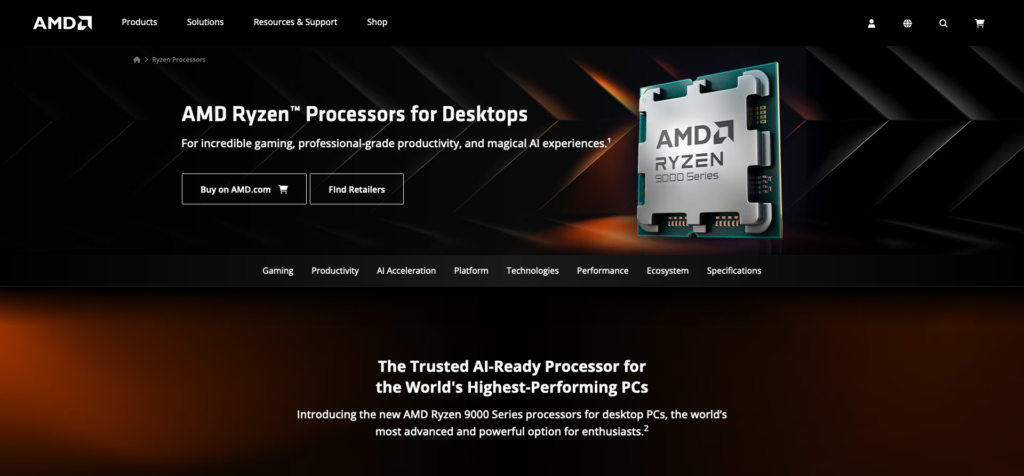AMD, SpaceX and Other News

AMD launches a number of new processors
AMD officially unveiled the Ryzen 9000 series of processors at Computex Taipei. The series is based on TSMC’s 4nm process and the Zen5 architecture, and can be equipped with up to two Zen5 mini-chips, each with up to eight cores, for a total of up to 16 cores and 32 threads, and support for multi-threading technology. The first four CPU offerings also come with 2CU RDNA2 graphics. These new processors are expected to be officially launched in July this year.
AMD also announced new Strix Point processors – AMD Ryzen AI 300 series APU products. All are based on the Zen5 architecture and come in configurations up to 12 cores and 24 threads with RDNA 3.5 GPUs (up to 16 CUs) and XDNA2 AI NPUs (delivering 50 TOPS of computing power). The first two mobile Ryzen AI 300 Series APUs are the AMD Ryzen AI 9 365 and AMD Ryzen AI 9 HX 370. The Ryzen AI 9 365 configuration includes a combination of 4 Zen5 cores and 6 Zen5c cores, a 34MB cache, a maximum frequency of 5.0GHz, and the AMD Radeon 880M GPU. The Ryzen AI 9 HX 370 features 4 Zen5 cores and 8 Zen5c cores, 36MB cache, a maximum frequency of 5.1GHz, and the AMD Radeon 890M GPU, and laptops with these APUs are expected to be available in the next quarter.
SpaceX plans to launch direct cellular connectivity this fall
In a filing, SpaceX has proposed a “Space Supplemental Coverage” program that aims to provide Internet connectivity to unmodified smartphones in the U.S. this fall via direct cellular data connectivity service, and to serve consumers in cellular blind spots.
SpaceX noted, however, that the FCC’s current rules for providing satellite connectivity to cellular phones present obstacles and urged the Commission to relax its restrictions on cellular satellite frequencies in general, and in particular to oppose the practice of “one-size-fits-all aggregated out-of-band transmit power flux densities. ‘SpaceX proposed to replace the current program with more granular ’band-specific limitations” to enhance coverage and reliability of the upcoming cellular Starlink system to enhance the coverage and reliability of the upcoming cellular Starlink system. The document also mentions that T-Mobile is the first U.S. carrier to use cellular Starlink technology.
Competitors including AT&T, Verizon and Dish Network are lobbying the commission to maintain the existing restrictions to prevent potential radio interference. Additionally, scientists are concerned that SpaceX’s cellular Starlink satellites could interfere with radio astronomy; SpaceX said it is already working with the astronomy community to mitigate these potential risks and recommended that the Commission coordinate with relevant companies and foundations before approving the operation of the satellite-linked service.
Dyson launches 360 Vis Nav smart vacuuming robot
On June 2, Dyson launched the 360 Vis Nav smart vacuuming robot, which maintains Dyson’s regular silver, purple, red, and black color scheme, with an overall D-shaped design with a right-angle front and curved back.
It has 65AW of suction power, far more than the mainstream sweeping robots on the market today, and built-in piezoelectric sensors to automatically monitor the concentration of dust in the environment and adjust the suction power. It is also equipped with an ultra-wide composite brush bar with a sweeping width of 27.8cm and a 0.5L HEPA filter box. As for the battery, the robot has a battery life of up to 50 minutes and supports functions such as power failure and sweeping back.
Study suggests security problems with Microsoft Recall
Cybersecurity experts say that the Recall feature automatically takes a screenshot of the screen every few seconds, recognizes it using the Azure OCR feature running on the user’s device, writes the recognized text to a SQLite database in the user’s folder, and records everything the user has ever viewed on the computer in plain text.
Recall is said to be part of the new Copilot+AI computers, which are scheduled for release on June 18. Recall utilizes local AI models to take screenshots of everything a user does on a PC and provides a searchable timeline feature. While Microsoft had promised that Recall data was secure and encrypted, that doesn’t seem to be the case at the moment, and an attacker could gain access to all of the data through malware.
Recall’s default enablement and inability to disable it during setup has raised concerns among privacy advocates. The UK Information Commissioner’s Office has stepped in to investigate. Microsoft, on the other hand, says Recall is an optional feature with built-in privacy control options, but none of this addresses the issue of malware potentially stealing databases. Microsoft is currently discussing whether to modify the setup process.
Posted on June 4, 2024 uninstalledly editor